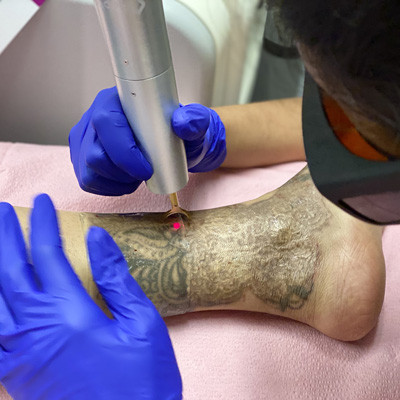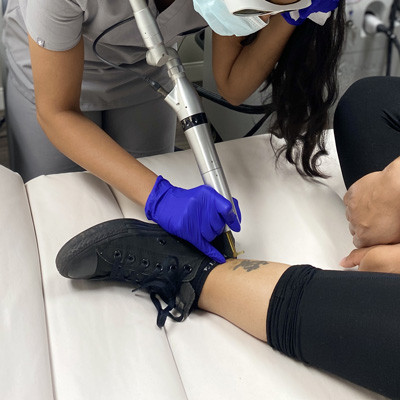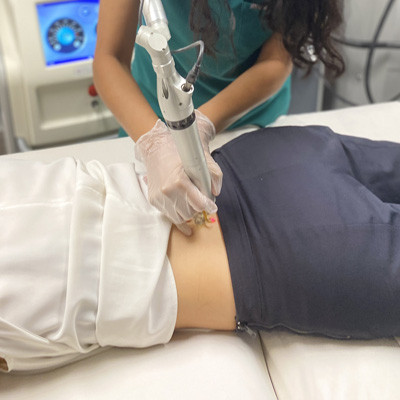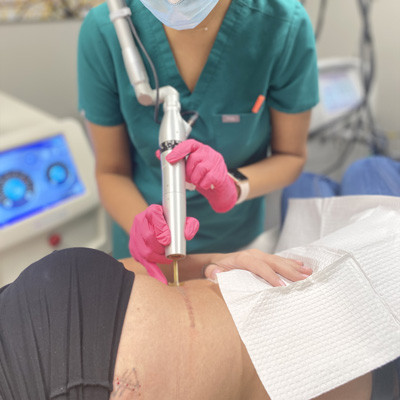Does Tattoo Removal Burn Skin? The answer is no, laser tattoo removal, offered by experts at tattooat.com, doesn’t “burn” the skin in the traditional sense, but it uses targeted laser energy to break down tattoo ink. This process allows your body to naturally eliminate the ink, fading the tattoo over time. Interested in removing an unwanted tattoo? Let’s explore the science, dispel myths, and understand how laser tattoo removal works, including aftercare tips and potential side effects, ensuring a safe and effective experience.
1. Understanding Laser Tattoo Removal: The Science Behind It
Laser tattoo removal doesn’t actually burn the skin, it works by using concentrated light energy. Instead, the method depends on the way that lasers target tattoo ink beneath the skin’s surface. Here’s a detailed breakdown of how this process works:
- Selective Targeting: Lasers emit specific wavelengths of light that are designed to be absorbed by the tattoo ink while minimizing damage to the surrounding skin.
- Ink Shattering: When the laser energy is applied, it heats up the ink particles, causing them to shatter into smaller fragments.
- Natural Elimination: Once the ink is broken down, the body’s immune system recognizes these particles as foreign substances and works to remove them naturally through the lymphatic system.
- Gradual Fading: Over several treatment sessions, the tattoo gradually fades as more and more ink is broken down and eliminated.
This method ensures that the tattoo removal process is effective while minimizing the risk of scarring or damage to the surrounding skin.
 Laser tattoo removal process
Laser tattoo removal process
Alt text: Laser tattoo removal procedure targeting ink particles, showing the ink shattering process.
2. Debunking the “Burning” Myth: What It Really Feels Like
Laser tattoo removal doesn’t burn the skin, despite the common perception. The sensation is often compared to:
- Rubber Band Snaps: Many people describe the feeling as similar to a rubber band snapping against the skin.
- Warm Pricks: Some may experience a sensation like warm pricks or light stinging.
- Quick Heat Pulses: The laser emits rapid pulses of heat, which can create a brief, intense sensation.
Modern clinics, like those partnered with tattooat.com, use advanced cooling methods and numbing creams to minimize discomfort. These techniques ensure that the process is as painless as possible.
3. Factors Influencing the Sensation of Laser Tattoo Removal
Several factors influence how laser tattoo removal feels. By understanding these elements, you can better prepare for the procedure.
- Pain Tolerance: Individual pain tolerance varies significantly. What one person finds manageable, another might find uncomfortable.
- Tattoo Location: Areas with more nerve endings, such as the wrists or ankles, may be more sensitive.
- Tattoo Size and Color: Larger tattoos or those with multiple colors might require longer sessions, potentially increasing discomfort.
- Laser Technology: Advanced lasers, like the PicoWay laser, deliver energy in ultra-short pulses, minimizing heat and discomfort.
- Numbing Creams: Topical numbing creams can significantly reduce pain by desensitizing the skin.
- Cooling Devices: Many clinics use cooling devices to soothe the skin during and after treatment.
By considering these factors and discussing them with your technician, you can optimize your comfort during the laser tattoo removal process.
4. What to Expect During a Laser Tattoo Removal Session
Knowing what to expect during a laser tattoo removal session can help alleviate anxiety. Here’s a step-by-step overview:
- Consultation: Discuss your tattoo removal goals, medical history, and any concerns with your technician.
- Preparation: The area will be cleaned and prepped, often with a topical numbing cream applied.
- Eye Protection: You will wear protective eyewear to shield your eyes from the laser.
- Laser Application: The technician will use a handheld laser device to target the tattoo ink.
- Cooling: A cooling device may be used to minimize heat and discomfort.
- Post-Treatment Care: After the session, the area will be cleaned and bandaged.
The length of each session depends on the size and complexity of the tattoo. Most sessions last between 15 to 60 minutes.
5. Potential Side Effects: Addressing Concerns
While laser tattoo removal doesn’t typically “burn” the skin, some side effects can occur. Understanding these potential issues helps you prepare and manage them effectively:
- Redness and Swelling: Common immediately after treatment, usually subsides within a few days.
- Blistering: Can occur as the skin heals, indicating the immune system is responding to the broken-down ink.
- Hyperpigmentation: Skin darkening, particularly in darker skin tones.
- Hypopigmentation: Skin lightening, more common with aggressive treatments.
- Scarring: Rare but possible, especially if proper aftercare is not followed.
- Infection: Risk is low with proper hygiene and care.
These side effects are generally temporary and manageable with proper aftercare.
 Redness after laser tattoo removal
Redness after laser tattoo removal
Alt text: Redness and slight swelling on skin post laser tattoo removal, indicating a normal reaction.
6. Choosing the Right Laser: Understanding Different Technologies
The effectiveness and safety of laser tattoo removal depend on the type of laser used. Here’s an overview of different laser technologies:
| Laser Type | Wavelength | Best For | Advantages | Disadvantages |
|---|---|---|---|---|
| Q-Switched Lasers | 1064 nm, 532 nm, 694 nm | Dark inks (black, blue), red inks | Effective for a wide range of ink colors, versatile | May require more sessions, potential for hyper/hypopigmentation |
| PicoWay Laser | 785 nm, 730 nm, 1064 nm | All ink colors, especially resistant ones | Ultra-short pulses minimize heat damage, effective on stubborn inks, fewer sessions required | Higher cost per session |
| Alexandrite | 755 nm | Green and blue inks | Effective on certain resistant colors, less risk of scarring | Not as effective on darker skin tones |
| Ruby Laser | 694 nm | Dark inks (black, blue, green) | Good for removing dark inks, effective on professional tattoos | Can cause hyper/hypopigmentation, not suitable for darker skin |
| Nd:YAG | 1064 nm, 532 nm | Dark inks (black, blue), red and orange inks | Versatile, can treat a broad range of skin types, effective on amateur tattoos | May require more sessions, potential for blistering |
Choosing the right laser technology is critical for achieving the best results with minimal side effects. Consult with a qualified technician to determine the best option for your tattoo.
7. Laser Tattoo Removal Aftercare: Ensuring Proper Healing
Proper aftercare is essential to minimize side effects and promote healing after laser tattoo removal. Follow these guidelines:
- Keep the Area Clean: Gently wash the treated area with mild soap and water.
- Apply Antibiotic Ointment: Use a thin layer of antibiotic ointment to prevent infection.
- Cover with a Bandage: Protect the area with a sterile bandage, changing it daily.
- Avoid Sun Exposure: Keep the treated area out of direct sunlight.
- Stay Hydrated: Drink plenty of water to support the body’s healing process.
- Avoid Picking or Scratching: Let blisters heal naturally to prevent scarring.
- Follow Up: Attend all scheduled follow-up appointments to monitor progress.
Consistent and careful aftercare is critical for achieving optimal results and avoiding complications.
8. The Role of Skin Type in Laser Tattoo Removal
Skin type plays a significant role in the success and safety of laser tattoo removal. Different skin tones react differently to laser treatments, which can affect the choice of laser and treatment settings:
- Lighter Skin: Generally, lighter skin tones respond well to a variety of lasers. There is a lower risk of hyperpigmentation or hypopigmentation.
- Darker Skin: Darker skin tones have a higher risk of pigment changes. Lasers with longer wavelengths, such as the Nd:YAG laser, are often preferred to minimize this risk.
A qualified technician will assess your skin type and customize the treatment plan accordingly to ensure the safest and most effective outcome.
9. Lifestyle Factors Affecting Tattoo Removal
Certain lifestyle factors can significantly impact the effectiveness of laser tattoo removal. Here are some key considerations:
- Smoking: Smoking constricts blood vessels, reducing blood flow to the treated area. This can slow down the healing process and make it harder for the body to clear the ink.
- Hydration: Staying hydrated helps the body flush out the shattered ink particles more efficiently.
- Sun Exposure: Excessive sun exposure can increase the risk of hyperpigmentation and interfere with the healing process.
- Immune System Health: A strong immune system is essential for removing the broken-down ink particles. Maintaining a healthy lifestyle, including a balanced diet and regular exercise, can support immune function.
Adopting a healthy lifestyle can enhance the results of laser tattoo removal and minimize potential complications.
10. The Cost of Laser Tattoo Removal: Factors to Consider
The cost of laser tattoo removal can vary widely depending on several factors. Understanding these variables can help you budget effectively:
- Tattoo Size: Larger tattoos require more treatment sessions and therefore cost more.
- Ink Colors: Tattoos with multiple or resistant colors may need more specialized laser treatments, increasing the cost.
- Location: Prices can vary based on the clinic’s location and overhead costs.
- Number of Sessions: The total cost will depend on the number of sessions needed to achieve the desired results.
- Laser Technology: Advanced lasers, like the PicoWay, may cost more per session but could require fewer sessions overall.
- Technician’s Expertise: Experienced technicians may charge more for their services.
According to research from Portland State University’s Art Department, in July 2025, the average cost per session in the USA ranges from $200 to $500.
 Tattoo removal costs comparison
Tattoo removal costs comparison
Alt text: A comparison table showing average costs for different types of tattoo removal lasers.
11. Alternatives to Laser Tattoo Removal
While laser tattoo removal is the most effective method, other options are available. These alternatives may be suitable for those who cannot undergo laser treatments or prefer different approaches:
- Surgical Excision: Involves cutting out the tattooed skin and stitching the remaining skin together. Effective for small tattoos but can leave a scar.
- Dermabrasion: Mechanically removes the outer layers of skin, causing the tattoo to fade. Can be painful and may result in scarring.
- Chemical Peels: Use chemical solutions to remove layers of skin, fading the tattoo over time. Less effective than laser removal and can cause skin irritation.
- Tattoo Removal Creams: Claim to fade tattoos with topical applications. Results are often minimal and inconsistent.
Each alternative has its own advantages and disadvantages. Consult with a dermatologist to determine the best option for your specific needs.
12. Finding a Qualified Tattoo Removal Specialist
Choosing the right specialist is crucial for a safe and effective tattoo removal experience. Here’s how to find a qualified provider:
- Check Credentials: Ensure the specialist is a licensed medical professional with experience in laser tattoo removal.
- Read Reviews: Look for online reviews and testimonials to gauge the provider’s reputation.
- Ask About Experience: Inquire about the number of tattoo removal procedures the specialist has performed.
- Inspect the Clinic: Ensure the clinic is clean, well-maintained, and equipped with advanced laser technology.
- Request a Consultation: Use the consultation to discuss your goals, ask questions, and assess the specialist’s knowledge and communication skills.
Selecting a qualified and experienced specialist can significantly reduce the risk of complications and improve the overall outcome.
13. How Many Sessions Will You Need?
The number of laser tattoo removal sessions varies. It depends on factors such as ink color, tattoo size, and skin type. Most people need 5-10 treatments for noticeable fading. Some may require more depending on their tattoo’s complexity.
14. Can All Tattoos Be Removed Completely?
Not all tattoos vanish entirely. Factors such as ink type, depth, and individual response impact complete removal. Some tattoos fade significantly, but faint shadows might persist. Consult with a specialist for realistic expectations.
15. What Are the Risks of Tattoo Removal?
Risks include skin discoloration, scarring, and infection. Hyperpigmentation (darkening) or hypopigmentation (lightening) can occur. Scarring is rare but possible, especially with improper aftercare. Follow your specialist’s instructions to minimize risks.
 Tattoo removal risks and precautions
Tattoo removal risks and precautions
Alt text: A visual representation illustrating the common risks and precautions during laser tattoo removal.
16. Managing Pain During Tattoo Removal
Pain varies among individuals. Options include topical numbing creams, ice packs, and cooling devices. Some clinics offer local anesthesia for enhanced comfort. Discuss pain management options with your specialist.
17. Black Ink: The Easiest to Remove
Black ink is the easiest to remove. It absorbs a wide range of laser wavelengths. Other colors, like green and blue, require specific lasers and more sessions.
18. What if You Have a Scar?
Scarring complicates the process. Treatment over scar tissue requires more sessions. Future scarring risk increases. Discuss any existing scars with your specialist before starting.
19. How Does Smoking Slow the Process?
Smoking slows the process by constricting blood vessels. This reduces blood flow and impairs ink particle removal. Quitting or reducing smoking improves results.
20. Should You Remove the Whole Tattoo?
Not necessarily. Selective removal erases specific parts. This is helpful for removing names or cleaning up edges. Fading also preps for cover-up tattoos.
Laser tattoo removal does not burn the skin, but knowing what to expect can ease any concern. By understanding the science behind laser tattoo removal, potential side effects, and aftercare practices, you can confidently take the next step towards saying goodbye to unwanted ink. For more information, explore design ideas, or find a skilled tattoo artist or removal specialist, visit tattooat.com today! Located at 1825 SW Broadway, Portland, OR 97201, United States, or call +1 (503) 725-3000.
FAQ: Addressing Your Burning Questions About Tattoo Removal
Here are some frequently asked questions to help you better understand laser tattoo removal:
- Is laser tattoo removal painful?
The sensation varies but is often described as similar to a rubber band snapping against the skin. Numbing creams and cooling devices can help minimize discomfort. - How many sessions will I need?
The number of sessions depends on the tattoo’s size, ink colors, and your skin type. Most people need 5-10 sessions. - Can all tattoos be completely removed?
While many tattoos can be significantly faded, complete removal isn’t always guaranteed. Faint shadows may persist. - What are the potential side effects?
Common side effects include redness, swelling, blistering, and temporary skin discoloration. Scarring is rare but possible. - How long does each session last?
Each session typically lasts between 15 to 60 minutes, depending on the size and complexity of the tattoo. - What should I do after each treatment?
Keep the area clean, apply antibiotic ointment, cover with a bandage, and avoid sun exposure. - Can I get laser tattoo removal if I have dark skin?
Yes, but it’s essential to choose a laser with a longer wavelength, such as the Nd:YAG laser, to minimize the risk of pigment changes. - How much does laser tattoo removal cost?
The cost varies depending on the tattoo’s size, ink colors, and the number of sessions required. The average cost per session ranges from $200 to $500 in the USA. - Are there any alternatives to laser tattoo removal?
Alternatives include surgical excision, dermabrasion, chemical peels, and tattoo removal creams. Laser removal is the most effective method. - How do I find a qualified tattoo removal specialist?
Check credentials, read reviews, ask about experience, inspect the clinic, and request a consultation to assess the specialist’s knowledge and communication skills.
